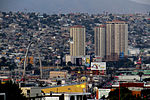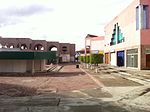Tijuana is the largest city in the state of Baja California located on the northwestern Pacific Coast of Mexico. Tijuana is the municipal seat of the Tijuana Municipality and the hub of the Tijuana metropolitan area. It has a close proximity to the Mexico–United States border, which is part of the San Diego-Tijuana metro area.
Tijuana is the 47th largest city in the Americas and is the westernmost city in Mexico. According to the 2015 census, the Tijuana metropolitan area was the fifth-largest in Mexico, with a population of 1,840,710, but rankings vary, the city (locality) itself was 6th largest and the municipality (administrative) third largest nationally. The international metropolitan region was estimated at 5,158,459 in 2016, making it the third-largest metropolitan area in The Californias, 19th-largest metropolitan area in the Americas, and the largest bi-national conurbation that is shared between US and Mexico. Tijuana is the second most populous city in Mexico and center of the 6th-largest metro area in Mexico, The city is one of the fastest-growing metro areas in the country and rated as a "High Sufficiency" global city by the Globalization and World Cities Research Network. As of September 2019, the city of Tijuana had a population of 1,810,645, with its metropolitan area containing a population of 2,157,853 as of 2020, an estimated 2,002,000 within the urban area.Tijuana traces its modern history to the arrival of Spanish colonists in the 16th century who were mapping the coast of the Californias. Following the division of the Californias after the American Conquest of California, Tijuana found itself located on an international border, giving rise to a new economic and political structure. The city was incorporated on 11 July 1889 as urban development began. The city has served as a major tourist destination since the 1880s. Today, Tijuana is a dominant manufacturing center for North America, hosting facilities of many multinational conglomerate companies. In the early 21st century, Tijuana has emerged as the medical device manufacturing capital of North America and is increasingly recognized as an important cultural Mecca for the border region of The Californias. The city is the most visited border city in the world, sharing a border of about 24 km (15 mi) with its sister city San Diego. More than fifty million people cross the border between these two cities every year.
Despite its popularity as a tourist destination, Tijuana is a hotbed of crime, especially violent crime, due to the extensive presence of organized crime and Mexican cartels. It regularly ranks among the most violent cities by homicide rate. According to Statista in August 2023, Tijuana presently has the second highest homicide rate in the world. The U.S. State Department maintains a travel advisory warning as of September 2023 relating to the city's "non-tourist areas." Incidents involving the murder or kidnapping of foreigners since the 2000s have also sparked travel fears and affected Tijuana's status among international tourists.









